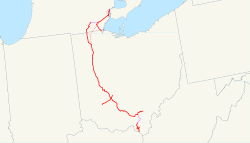DT&I
 |
|

DT&I system as of 1918
|
|
| Reporting mark | DTI |
|---|---|
| Locale | Michigan and Ohio |
| Dates of operation | 1905–1983 |
| Successor | Grand Trunk Western |
| Track gauge | 4 ft 8 1⁄2 in (1,435 mm) standard gauge |
The Detroit, Toledo and Ironton Railroad (reporting mark DTI) operated between its namesake cities of Detroit, Michigan and Ironton, Ohio via Toledo between 1905 and 1983. At the end of 1970 it operated 478 miles of road on 762 miles of track; that year it carried 1244 million ton-miles of revenue freight.
In 1901, the merger of the Detroit and Lima Northern Railway and the Ohio Southern Railway formed the Detroit Southern Railroad. This company was purchased at foreclosure on May 1, 1905 by Harry B. Hollins & Company of New York, which reincorporated it in the state of Michigan under the name of the Detroit, Toledo and Ironton Railway.
Samuel Hunt, president of the Detroit Southern Railroad, was to remain president of the reorganized Detroit, Toledo and Ironton Railway. However, he died suddenly on May 15, 1905. George Miller Cumming, a lawyer based in New York City who was the former first vice-president of the Erie Railroad Company and the former chairman of the board of the Cincinnati, Hamilton and Dayton railroad, was elected president in June and served for one month. F. A. Durban was elected president in July but resigned in November, at which time he was replaced by Eugene Zimmerman. (Both Cumming and Durban continued to serve as officers under Zimmerman's presidency.)
The line went bankrupt in 1908, but remained solvent until it was purchased by Henry Ford in 1920. Ford recognized the strategic importance of the line to his automobile business as the line left Dearborn, Michigan and connected with all of the major east-west rail lines in the Midwest. This gave Ford direct control over shipments of raw materials and finished goods to and from his factories in Dearborn. The line thrived and saw numerous improvements under Ford's management. However, Ford sold the line in 1929 to the Pennsylvania Railroad after becoming disgusted with interference and over regulation from the Interstate Commerce Commission.
...
Wikipedia
